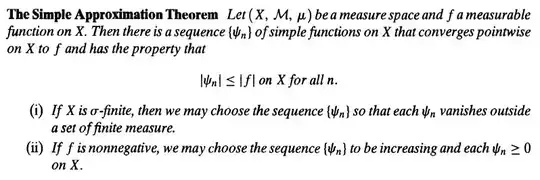Suppose $f,g\in L^2(\mathbb{R})$, how to show that $$\lim_{n\rightarrow \infty}\int_\mathbb{R}f(x)g(x+n)=0$$
If functions in $L^p(\mathbb{R})$ vanish outside of a set of finite measure, then we can assume $E=\{x|f(x)\neq 0\}$ and $F=\{x|g(x)\neq 0\}$ and $E$ and $F$ are measurable. And we defien $F_n=\{x|g(x+n)\neq 0\}$.
So can we find $n$ such that $m(F_n\cap E)\leq1/n$?
I have another idea that is to use Simple Approximation Theorem to prove.
Here is the Simple Approximation Theorem:

update
In general it is not true that functions in $L^p(\mathbb{R})$ vanish outside of a set of finite measure(counterexample see @Ant 's comment). However it is true that simple functions in $L^p(\mathbb{R})$ vanish outside of a set of finite measure.